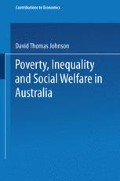Abstract
Researchers aiming to measure poverty, inequality and social welfare need to make important decisions about the appropriate target group, about the unit of analysis, in Sen’s (1992) terminology the target space, and about the period over which the analysis may be conducted. It is likely that there will be no single correct answer for all measurements of poverty. Some choices of group, of space and of period will be relevant in some contexts, others in other contexts. Similarly there will be no correct group, space or time period for the study of inequality and social welfare. Also, in general, given the definitions of the previous chapter, it is not necessarily true that the target groups, target spaces and even periods of analysis will be common to poverty, inequality and welfare.
Access this chapter
Tax calculation will be finalised at checkout
Purchases are for personal use only
Preview
Unable to display preview. Download preview PDF.
Reference
The ABS (1995, p. 28) defines income units as collections of people who live together and share both income and expenditure and families as groups of income units related by blood or marriage who have shared eating and living arrangements but do not pool their income.
Households in the ABS (1995) terminology are, as defined here, collections of people living at the same address who have some common living arrangements but do not share income are not necessarily related and between whom there are imputed or actual transfers so that expenditure may also be treated separately. Thus in the definition used in this book there is no distinction between families and households and the term families is used in its more general sense.
Though of course the relativities may change at different levels. Nevertheless within a range that all people may agree applies to the poor, the relativities are likely to be constant.
Named after Engel who observed that family expenditures may be divided into necessities and luxuries and as income increases expenditure on necessities increases less than proportionately, and in a systematic way. The same standard of living is reached when necessities cost the same proportion of income among different types of families. Equivalence scales may be deduced by comparing the total income of families in which necessities form the same proportion of total spending.
Bradbury (1992) has explored these issues and broadly agrees with the conclusions stated here. He derives the welfare and utility functions for families using one and two period models.
Ideally a measure of social welfare would be made using equivalence scales which reflected the relative utility of different social arrangements such as having children, getting married and so on.
Recent work by Saunders (1992) and Whiteford & Kennedy (1995) suggests that the effect of non-cash income varies across countries. Both studies utilise the LIS database which contains detailed income and household records from up to 20 countries maintained on a consistent definitional basis.
In many instances the comparison may not be explicit. Studies which claim say that the level of poverty among a particular group is x per cent are implicitly comparing that x with some other state, usually the state in which there is no poverty, that is where x has the value zero. Studies which don’t explicitly state the point of comparison are the most problematic since the reader has no guidance of the appropriate context in which to take the results.
Investments in national accounts are valued at cost but the value to the society is, presumably, much greater than this. Much investment in education and training is not formally included in investment but would appear, again at cost, in consumption of education services for instance. Scott (1989) details many problems with conventional treatment of investment.
The construction of such models has been an area of much recent progress. Gallagher (1990) presents a comprehension compilation of recent models used, developing or mooted in Australia including a detailed comparison of their features. In the same volume Hellwig (1990) describes the overseas experience. Atkinson and Sutherland (1988) also document microanalytic modelling in Europe. Harding (1994) provides a recent example of the use of these models.
Author information
Authors and Affiliations
Rights and permissions
Copyright information
© 1996 Springer-Verlag Berlin Heidelberg
About this chapter
Cite this chapter
Johnson, D.T. (1996). Units of Analysis. In: Poverty, Inequality and Social Welfare in Australia. Contributions to Economics. Physica, Heidelberg. https://doi.org/10.1007/978-3-662-12729-2_2
Download citation
DOI: https://doi.org/10.1007/978-3-662-12729-2_2
Publisher Name: Physica, Heidelberg
Print ISBN: 978-3-7908-0942-8
Online ISBN: 978-3-662-12729-2
eBook Packages: Springer Book Archive

